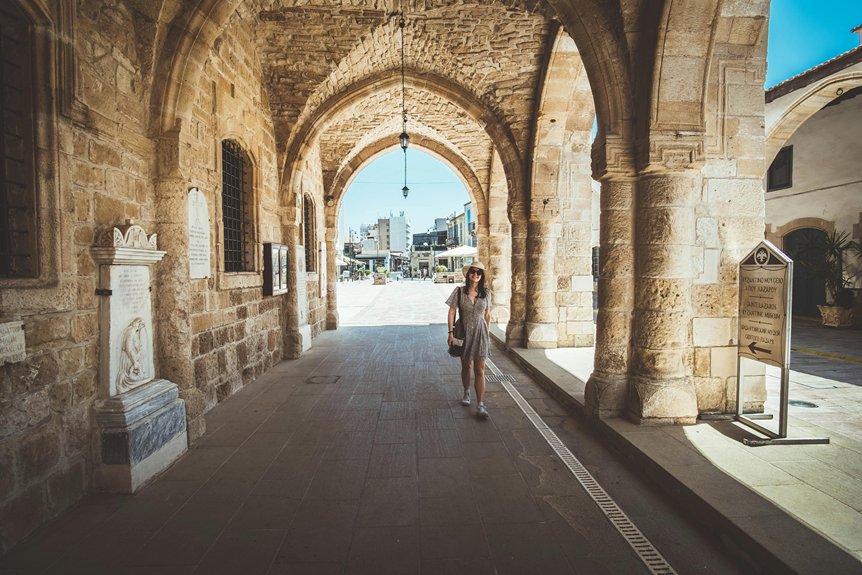You’ll navigate Nicosia’s complex heritage by crossing UN checkpoints and exploring medieval Venetian walls spanning over 5 miles. Traverse the buffer zone between Greek and Turkish quarters, witnessing architectural treasures like the Omeriye Mosque and Famagusta Gate. Local guides will illuminate the city’s intricate cultural narratives, transforming historical sites into intimate journeys through Cyprus’s profound geopolitical landscape. Your exploration promises deeper revelations at every turn.
Key Takeaways
- Begin at the Venetian Walls near Famagusta Gate, exploring the medieval fortifications that symbolize Nicosia’s historical strategic importance and architectural resilience.
- Cross the UN Buffer Zone through authorized checkpoints, observing the unique geopolitical landscape that divides and connects Greek and Turkish Cypriot territories.
- Visit the Laiki Geitonia neighborhood to experience Venetian-style restored buildings and the Omeriye Mosque, showcasing the architectural diversity of the city’s cultural heritage.
- Explore the Archbishop’s Palace and Agios Ioannis Cathedral to understand the rich religious and architectural tapestry of Nicosia’s Greek quarter.
- Engage with local guides at key heritage sites to gain personal insights into the nuanced historical narratives and contemporary cultural dynamics of Cyprus.
Discovering Nicosia’s Historic Divide
As you step into Nicosia’s historic landscape, the city’s profound division becomes immediately palpable. Greek Turkish heritage walks reveal the intricate layers of conflict etched into the urban fabric, where medieval walls and UN-monitored buffer zones symbolize decades of territorial tension. The medieval fortifications, constructed between the 11th and 16th centuries, offer a strategic vantage point for understanding the complex geopolitical narrative that has bifurcated this ancient capital.
Navigating the boundary between Greek Cypriot and Turkish Cypriot territories, you’ll encounter a living museum of historical complexity. The buffer zone serves not merely as a physical demarcation but as an expression of the nuanced aspirations and competing narratives of two communities intimately connected yet politically divided. Each step through this contested landscape discloses layers of cultural memory, sovereignty disputes, and the human stories that transcend simplistic territorial boundaries.
Medieval Walls and Venetian Fortifications
The medieval walls of Nicosia stand as a record of the city’s complex architectural and geopolitical heritage, encapsulating centuries of strategic fortification and cultural shift. As you explore these remarkable fortifications, you’ll discover over 5 miles of meticulously constructed defensive structures dating from the 11th to 16th centuries. The Venetians profoundly enhanced these walls, creating some of the most well-preserved medieval fortifications in the Eastern Mediterranean.
At the Famagusta Gate, you’ll encounter an impressive entrance featuring a vaulted passage and a domed room that reveals the architectural sophistication of the era. The Podocataro Bastion offers a strategic vantage point, allowing you to comprehend the intricate historical layers of Nicosia’s urban landscape. These walls aren’t merely stone and mortar; they’re a depiction of the city’s resilience, bearing witness to numerous historical changes and serving as a physical manifestation of Nicosia’s enduring strategic importance.
Crossing the UN Buffer Zone
While few urban landscapes present such a stark geographical and political division, Nicosia’s UN Buffer Zone represents a profound chronicle to the city’s complex geopolitical history. As you navigate this carefully monitored boundary, you’ll encounter a tangible manifestation of Cyprus’s divided identity. The security checkpoints serve as gateways between distinctly different cultural regions, requiring careful documentation and deliberate passage.
You’ll discover that crossing the buffer zone isn’t merely a physical shift but an immersive historical experience. The United Nations’ vigilant oversight maintains a controlled environment where you can witness the nuanced separation between Greek and Turkish Cypriot territories. Each step through this zone offers insights into the intricate social dynamics that have shaped Nicosia’s landscape.
Exploring this unique urban corridor allows you to comprehend the multifaceted nature of coexistence, territorial boundaries, and the ongoing complexities of Cyprus’s political narrative. The buffer zone stands as a living record to the city’s divided yet interconnected heritage.
Architectural Treasures of Greek and Turkish Quarters
Wandering through Nicosia’s architectural landscape reveals a mesmerizing narrative of cultural convergence, where Greek and Turkish architectural traditions intertwine with remarkable historical depth. You’ll discover the Venetian-style Laiki Geitonia neighborhood, where 18th-century restored buildings showcase intricate architectural details that reflect the city’s complex historical layers. The Omeriye Mosque exemplifies Ottoman-Turkish architectural influences, while the Famagusta Gate stands as a monument to the city’s medieval Venetian fortifications, originally constructed in the 14th century and reconstructed in the 16th century.
Your architectural exploration continues with the Agios Ioannis Cathedral, featuring a modest exterior that conceals an extraordinary gilded Franco-Byzantine interior. The Archbishop’s Palace, constructed in a neo-Byzantine style, houses the Byzantine Museum and Archdiocese Library, offering profound insights into Nicosia’s cultural heritage. The Faneromeni Church further illustrates this architectural diversity, blending Byzantine, Latin, and neoclassical elements in its compelling structural composition.
Cultural Insights From Local Guides
Architectural narratives give way to human stories as local guides become the living conduits of Nicosia’s intricate Greek-Turkish heritage. These trained professionals transform historical sites into deeply personal journeys, offering visitors nuanced perspectives on the city’s complex divided landscape.
In Nicosia, local guides weave personal narratives that bridge historical divides through intimate, emotional storytelling.
Their storytelling approach reveals the human dimension through:
- Personal anecdotes that humanize the Greek and Turkish community experiences, bridging historical divides with intimate, firsthand accounts
- Skillful navigation of multifaceted narratives surrounding Cyprus’s partition, presenting balanced interpretations that challenge simplistic historical perspectives
- Immersive commentary that connects visitors emotionally to the city’s layered cultural dynamics, transcending traditional touristic encounters
Must-See Heritage Sites and Landmarks
Although Nicosia’s divided urban landscape might initially seem challenging, its heritage sites offer profound insights into the city’s rich, multilayered history. You’ll discover remarkable landmarks that span centuries, such as the Podocataro Bastion and Medieval Venetian Walls, which represent one of the most well-preserved fortification systems in the Eastern Mediterranean. The Famagusta Gate, with its impressive vaulted passage and domed room, serves as an indication of the city’s architectural complexity.
Within the city’s historical core, you’ll encounter religious sites that reflect diverse cultural influences. The Agios Ioannis Cathedral showcases a stunning Franco-Byzantine style, featuring a modest exterior contrasted by an intricate gilded interior. Nearby, the Omeriye Mosque-originally a 14th-century Augustinian monastery-exemplifies the architectural transformation brought by Ottoman rule. The Leventis Municipal Museum further enriches your understanding, displaying archaeological artifacts and historical documents that trace Nicosia’s evolution from 3000 BC to the present day.
Navigating Between Two Communities
The Green Line-Nicosia’s UN-monitored buffer zone-serves as a tangible metaphor for the city’s complex geopolitical landscape, where physical barriers intersect with human narratives of division and potential reconciliation.
When traversing this divided terrain, you’ll encounter nuanced experiences that challenge simplistic perceptions of conflict:
- Crossing checkpoints requires careful observation of cultural sensitivities, understanding that each side harbors deeply personal historical interpretations.
- Engaging with local tour guides reveals multilayered perspectives, where personal stories transcend official political narratives and illuminate human resilience.
- Walking through heritage sites demands empathetic listening, recognizing that reconciliation emerges not from dismissing differences, but from acknowledging them with intellectual humility.
The buffer zone becomes more than a geographical boundary-it’s a living archive of Cyprus’s intricate social fabric. By approaching this space with scholarly curiosity and respectful engagement, you’ll uncover the profound human dimensions underlying territorial divisions, transforming historical barriers into potential bridges of understanding.
Practical Tips for Walking Tour Exploration
Bridging historical narratives requires practical preparation, and exploring Nicosia’s divided urban landscape demands strategic planning. You’ll want to equip yourself with comfortable walking shoes to navigate the 2.2 km route through historic streets and neighborhoods, ensuring minimal fatigue during your cultural exploration.
Hydration and sun protection are critical, as the tour’s outdoor segments may expose you to direct sunlight. Bring sufficient water and wear appropriate protective gear like sunscreen, a hat, and lightweight, breathable clothing to maintain comfort throughout the 2-3 hour experience.
The tour’s flexible cancellation policy-offering free cancellation up to 24 hours in advance-provides travelers with valuable planning flexibility. Additionally, most heritage sites like the Omeriye Mosque and Famagusta Gate offer free admission, making this walking tour an economically accessible method of understanding Nicosia’s complex cultural landscape and historical divisions.
Frequently Asked Questions
Is It Safe to Walk Between the Greek and Turkish Sides of Nicosia?
You’ll find crossing between the Greek and Turkish sides of Nicosia relatively safe, though it requires traversing the UN-controlled buffer zone at the Ledra Street checkpoint. You’ll need your passport and should remain aware of geopolitical sensitivities. While tensions historically existed, today’s crossing is well-managed and peaceful. You’ll encounter minimal risk if you respect local protocols, maintain a neutral demeanor, and follow standard border-crossing procedures. It’s an intriguing cultural experience.
How Long Does a Typical Heritage Walking Tour Take?
Like a bridge connecting two worlds, a Nicosia heritage walking tour typically spans 2-3 hours. You’ll traverse centuries of history, exploring architectural gems and cultural crossroads. The tour covers approximately 3-4 kilometers, weaving through historic districts, crossing the UN buffer zone, and revealing layers of Greek and Turkish interactions. You’ll want comfortable walking shoes and a curiosity for intricate urban narratives that blend architectural and cultural heritage.
What Should I Wear When Visiting Religious and Historical Sites?
When visiting religious and historical sites, you’ll want to dress respectfully and modestly. Opt for clothing that covers shoulders, knees, and sometimes arms, regardless of gender. Choose lightweight, breathable fabrics for comfort in warm climates. Avoid revealing or tight-fitting attire. Comfortable walking shoes are essential, as you’ll likely encounter uneven terrain. Consider carrying a lightweight scarf or jacket to cover up if needed, demonstrating cultural sensitivity.
Can I Use Euros or Do I Need Different Currencies?
Currency is the lifeblood of travel, flowing through your journey like a financial river. In Nicosia, you’ll navigate a unique monetary landscape. The Republic of Cyprus uses euros, while the Turkish Republic of Northern Cyprus uses Turkish lira. You’ll want to carry both currencies when exploring the city’s divided spaces. ATMs are widely available, and major credit cards are accepted in most tourist areas, ensuring smooth transactions across the cultural divide.
Are Photography and Filming Permitted During the Walking Tour?
Photography and filming regulations vary across different heritage sites in Nicosia. You’ll want to verify specific guidelines at each location, as some museums, religious structures, and historical landmarks have distinct policies. Generally, you’re permitted to take photographs in most outdoor spaces, but indoor sites might restrict camera use. Always ask local guides or site attendants for precise permissions, and be respectful of cultural sensitivities when capturing images.
Conclusion
You’ll discover Nicosia’s layered history isn’t just about physical boundaries, but complex human narratives woven through centuries of cultural intersection. Walking these heritage sites transforms abstract geopolitical divisions into tangible, intimate experiences of shared architectural memory. By traversing this UN buffer zone, you’re not merely a tourist, but a witness to resilience, understanding how divided spaces can paradoxically unite human understanding.

Meet Natalie, who has lived on Cyprus for the last 10 years. She loves exploring the beautiful nature of the island, like quiet forests and untouched beaches. Natalie has lots of cool experiences to share. Join her as she talks about her adventures in Cyprus.

